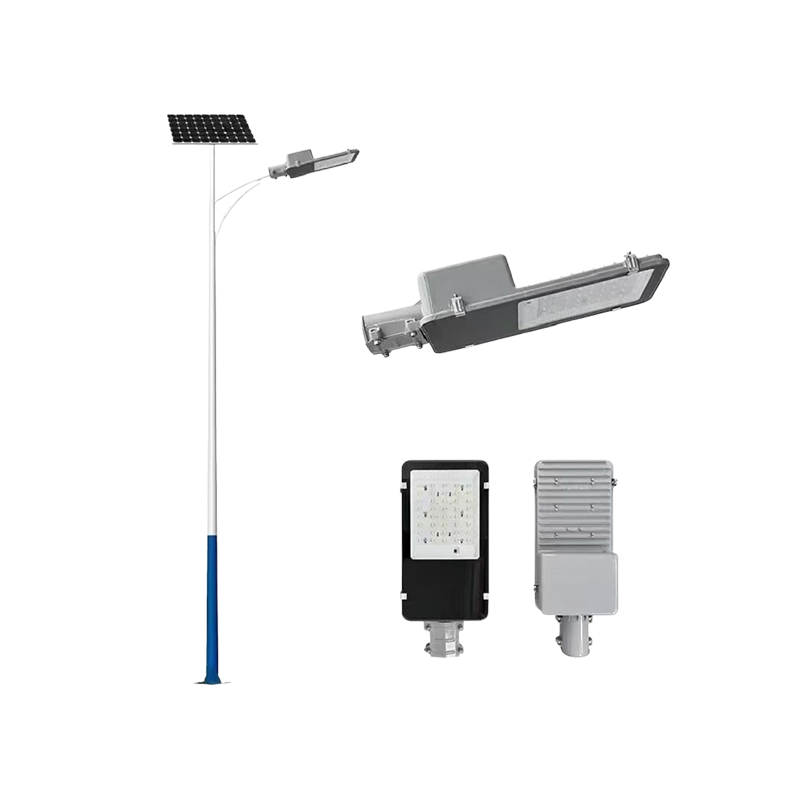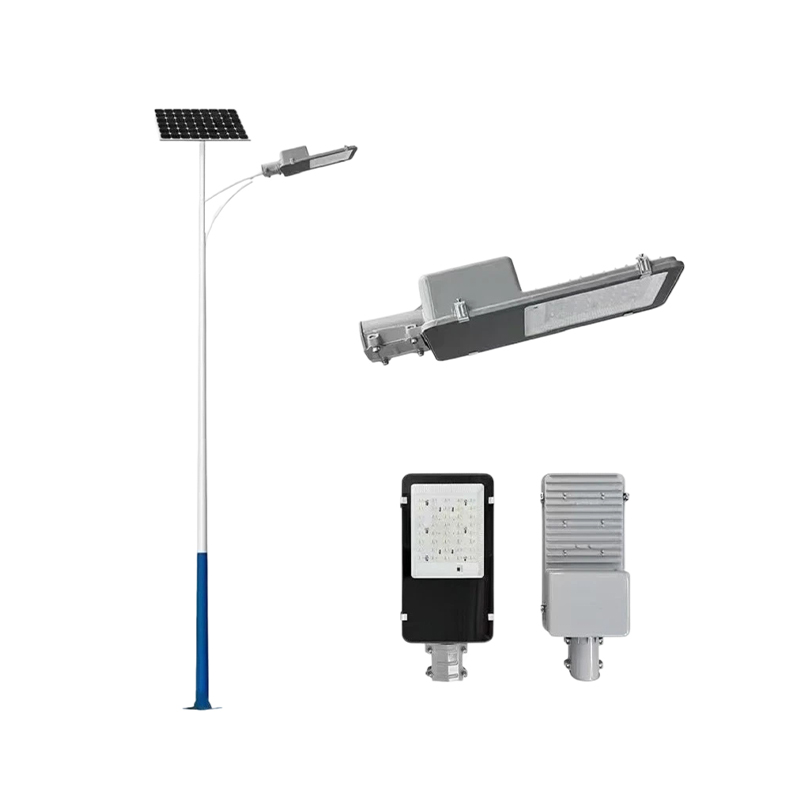How do solar street lights contribute to urban landscape beautification?
Release Time : 2025-11-06
In today's era of parallel urban renewal and ecological civilization construction, public lighting is no longer merely satisfied with the basic function of "illuminating the night," but has been entrusted with the important mission of shaping the city's image, enhancing spatial quality, and conveying humanistic warmth. As a product of the integration of green technology and modern design, solar street lights, with their unique form, flexible layout, and eco-friendly attributes, are quietly becoming "invisible designers" of urban landscape beautification. They not only illuminate the streets but also inject a fresh and futuristic aesthetic into the city with a simple, intelligent, and sustainable approach.
1. Simple and Modern Design Language, Matching Contemporary Urban Aesthetics
Traditional streetlights are often bulky, with exposed cables, thick poles, and limited by power supply, resulting in a homogenized design. Solar street lights, however, require no external cables, making their overall design lighter, simpler, and more integrated. The photovoltaic panels and lamp heads often adopt a streamlined integrated design or are hidden within biomimetic shapes; the lamp poles can be made of slender metal, wood composite materials, or even artistic castings, with smooth lines and harmonious proportions. This simplified industrial aesthetic aligns perfectly with the "clean, transparent, and orderly" visual style sought after by modern cities, making it particularly suitable for areas with high landscape requirements, such as park walkways, waterfront greenways, and cultural districts. It becomes a street installation that combines functionality and artistry.
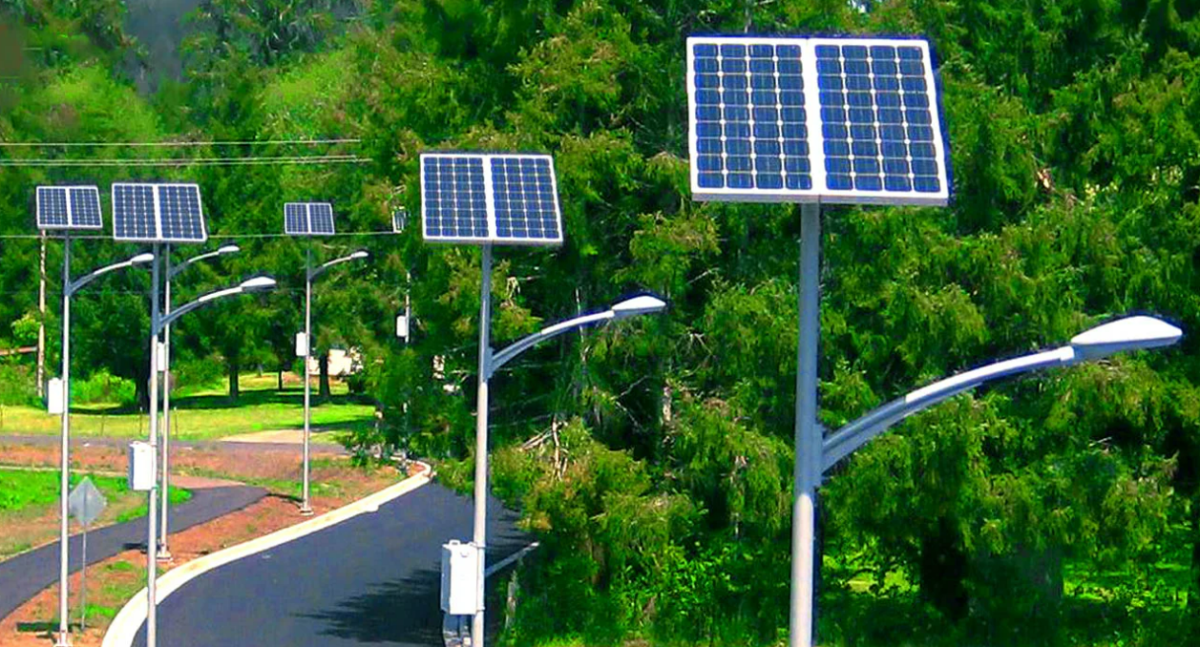
2. Flexible Layout Breaks Spatial Limitations, Activating Micro-Landscape Nodes
Since it doesn't rely on the power grid, solar street lights can be deployed and arranged freely as needed, unrestricted by underground pipelines or distribution boxes. Designers can flexibly set up single lights, double lights, or array combinations based on the landscape rhythm, pedestrian density, or focal point, even precisely placing them in locations traditionally difficult to wire, such as the center of lawns, tree pit edges, and plaza corners. This freedom of "lighting wherever it's needed" allows lighting to truly serve the spatial narrative—for example, placing low-profile, in-ground solar lights next to landscape features to highlight the sculpture's outline; using staggered, soft light columns along tree-lined paths to create a rhythmic sense of changing views. Lighting thus transcends an ancillary facility and becomes a constituent element of the landscape.
3. Controllable Color and Lighting Effects, Creating Diverse Nighttime Atmospheres
Solar street lights generally use high color rendering LED light sources, supporting color temperature adjustment and intelligent brightness control. Warm white light creates a welcoming community atmosphere, neutral light is suitable for commercial pedestrian streets, and cool white light is used on main roads to ensure safety. Combined with an intelligent sensing system, it can also achieve dynamic lighting that turns on when people are present and turns off when they leave, avoiding light pollution. Some high-end products even integrate RGB color light modules, which can change colors during festivals or special events, matching the city's festive themes and creating an immersive light and shadow experience. This "programmable light" makes the urban nightscape more layered and emotionally resonant.
4. Ecological Imagery Enhances the Green City Image
Solar street lights themselves are a concrete symbol of "green energy." The photovoltaic panels on top resemble leaves growing towards the sun, silently conveying the city's values of low-carbon, environmental protection, and self-sufficiency. In ecological parks, low-carbon demonstration zones, or sponge city projects, rows of solar street lights not only provide lighting but also become a tangible demonstration of sustainable living for citizens. This "visible green technology" helps raise public awareness of environmental protection, cultivate an "eco-friendly" brand image for the city, and enhance residents' sense of belonging and pride.
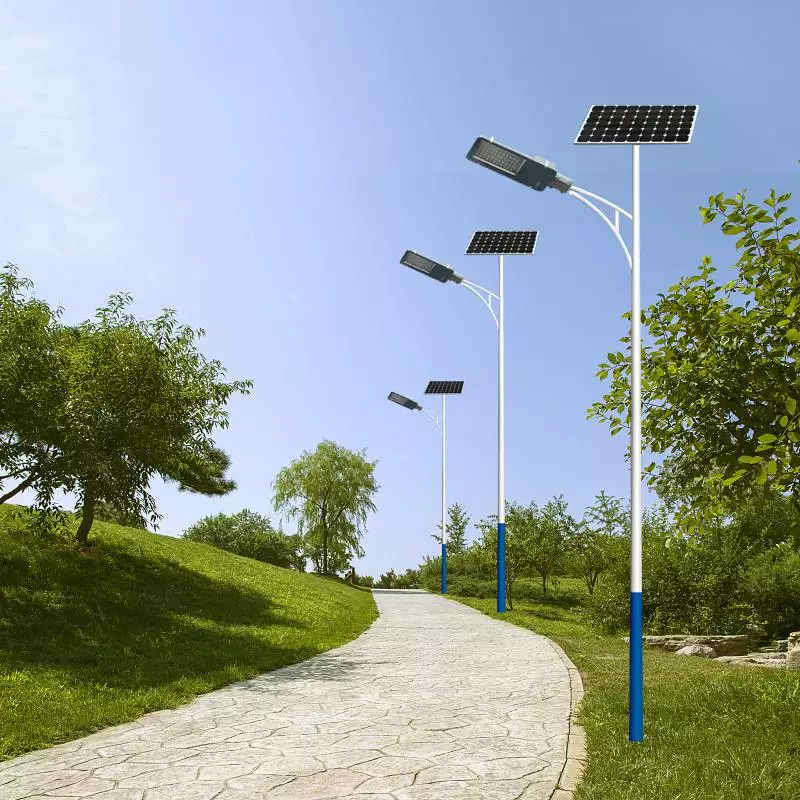
5. Reduced ground excavation and cable clutter, improving street cleanliness
Traditional street light construction requires large-scale road excavation to lay cables, easily damaging existing paving and greenery. Subsequent maintenance requires repeated road clearing, affecting the city's appearance. Solar street lights, however, use independent foundations for installation, requiring almost no civil engineering work and minimal disruption to the existing landscape. Furthermore, there are no exposed wires, distribution boxes, or manhole covers, resulting in clean and tidy streets with a more refreshing visual appeal. This advantage is particularly valuable in sensitive areas such as historic districts or cobblestone streets, preserving the original character while achieving a modern lighting upgrade.
6. Customization potential to enhance urban cultural expression
Thanks to its modular design, solar street lights support a high degree of customization in appearance, materials, and patterns. Light poles can be engraved with local patterns, photovoltaic panel frames can incorporate regional colors, and bases can incorporate city logos or cultural symbols. For example, the water towns of Jiangnan can use bluish-gray aluminum alloy lamp bodies with wave patterns; northwestern cities can choose rugged cast iron designs to echo the regional character. This possibility of "a thousand cities, a thousand faces" allows solar street lights to transcend the scope of general products, becoming a carrier of local cultural memory and helping to shape a city's differentiated image.
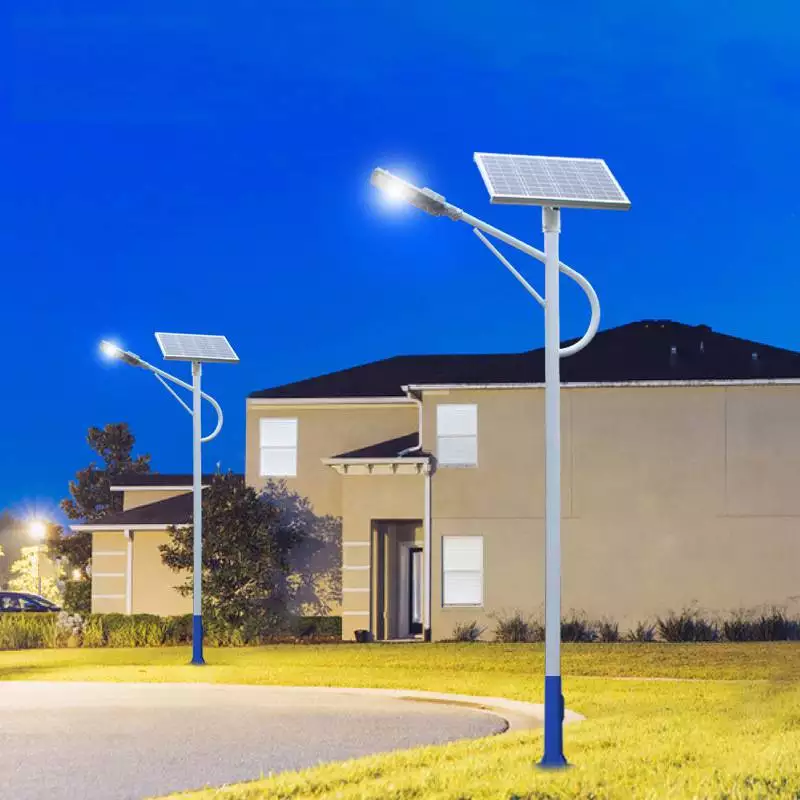
The beautification of the urban landscape by solar street lights goes far beyond the embellishment of "a single light," but rather a comprehensive enhancement of the system, ecology, and humanity. With technology as its backbone, design as its form, and green as its soul, it illuminates the way home while subtly reshaping the city's nighttime texture and spirit. When clean energy meets aesthetic design, each solar street light is a gentle love letter from the city to the future—quiet, bright, and full of hope.
1. Simple and Modern Design Language, Matching Contemporary Urban Aesthetics
Traditional streetlights are often bulky, with exposed cables, thick poles, and limited by power supply, resulting in a homogenized design. Solar street lights, however, require no external cables, making their overall design lighter, simpler, and more integrated. The photovoltaic panels and lamp heads often adopt a streamlined integrated design or are hidden within biomimetic shapes; the lamp poles can be made of slender metal, wood composite materials, or even artistic castings, with smooth lines and harmonious proportions. This simplified industrial aesthetic aligns perfectly with the "clean, transparent, and orderly" visual style sought after by modern cities, making it particularly suitable for areas with high landscape requirements, such as park walkways, waterfront greenways, and cultural districts. It becomes a street installation that combines functionality and artistry.

2. Flexible Layout Breaks Spatial Limitations, Activating Micro-Landscape Nodes
Since it doesn't rely on the power grid, solar street lights can be deployed and arranged freely as needed, unrestricted by underground pipelines or distribution boxes. Designers can flexibly set up single lights, double lights, or array combinations based on the landscape rhythm, pedestrian density, or focal point, even precisely placing them in locations traditionally difficult to wire, such as the center of lawns, tree pit edges, and plaza corners. This freedom of "lighting wherever it's needed" allows lighting to truly serve the spatial narrative—for example, placing low-profile, in-ground solar lights next to landscape features to highlight the sculpture's outline; using staggered, soft light columns along tree-lined paths to create a rhythmic sense of changing views. Lighting thus transcends an ancillary facility and becomes a constituent element of the landscape.
3. Controllable Color and Lighting Effects, Creating Diverse Nighttime Atmospheres
Solar street lights generally use high color rendering LED light sources, supporting color temperature adjustment and intelligent brightness control. Warm white light creates a welcoming community atmosphere, neutral light is suitable for commercial pedestrian streets, and cool white light is used on main roads to ensure safety. Combined with an intelligent sensing system, it can also achieve dynamic lighting that turns on when people are present and turns off when they leave, avoiding light pollution. Some high-end products even integrate RGB color light modules, which can change colors during festivals or special events, matching the city's festive themes and creating an immersive light and shadow experience. This "programmable light" makes the urban nightscape more layered and emotionally resonant.
4. Ecological Imagery Enhances the Green City Image
Solar street lights themselves are a concrete symbol of "green energy." The photovoltaic panels on top resemble leaves growing towards the sun, silently conveying the city's values of low-carbon, environmental protection, and self-sufficiency. In ecological parks, low-carbon demonstration zones, or sponge city projects, rows of solar street lights not only provide lighting but also become a tangible demonstration of sustainable living for citizens. This "visible green technology" helps raise public awareness of environmental protection, cultivate an "eco-friendly" brand image for the city, and enhance residents' sense of belonging and pride.

5. Reduced ground excavation and cable clutter, improving street cleanliness
Traditional street light construction requires large-scale road excavation to lay cables, easily damaging existing paving and greenery. Subsequent maintenance requires repeated road clearing, affecting the city's appearance. Solar street lights, however, use independent foundations for installation, requiring almost no civil engineering work and minimal disruption to the existing landscape. Furthermore, there are no exposed wires, distribution boxes, or manhole covers, resulting in clean and tidy streets with a more refreshing visual appeal. This advantage is particularly valuable in sensitive areas such as historic districts or cobblestone streets, preserving the original character while achieving a modern lighting upgrade.
6. Customization potential to enhance urban cultural expression
Thanks to its modular design, solar street lights support a high degree of customization in appearance, materials, and patterns. Light poles can be engraved with local patterns, photovoltaic panel frames can incorporate regional colors, and bases can incorporate city logos or cultural symbols. For example, the water towns of Jiangnan can use bluish-gray aluminum alloy lamp bodies with wave patterns; northwestern cities can choose rugged cast iron designs to echo the regional character. This possibility of "a thousand cities, a thousand faces" allows solar street lights to transcend the scope of general products, becoming a carrier of local cultural memory and helping to shape a city's differentiated image.

The beautification of the urban landscape by solar street lights goes far beyond the embellishment of "a single light," but rather a comprehensive enhancement of the system, ecology, and humanity. With technology as its backbone, design as its form, and green as its soul, it illuminates the way home while subtly reshaping the city's nighttime texture and spirit. When clean energy meets aesthetic design, each solar street light is a gentle love letter from the city to the future—quiet, bright, and full of hope.

